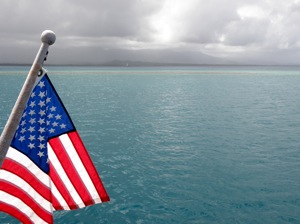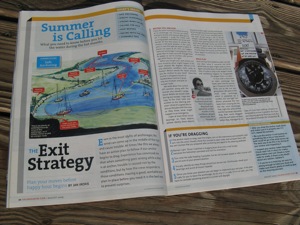Even in the most idyllic of anchorages, the wind can come up in the middle of the night and cause trouble. At times like this we always have an action plan to follow if our anchor begins to drag. Experienced has convinced me that when something goes wrong while a boat is at anchor, trouble is caused not by the conditions, but by how the crew responds to those conditions. Having a good, workable exit plan in place before you need it is the best way to prevent surprises.
The article “The Exit Strategy”, an edited condensed version of the following post, appeared in SAIL Magazine, August 2009.
With no moonlight to intrude on the brilliant starry skies, we sway in the hammock watching falling stars, thrilled that we are, at last, living the cruising dream. The anchorage is one we dreamed of: San Blas Islands, Panama, palm studded islands fringed with white sand beaches and surrounded by breaking reefs keeping the clear aqua waters calm. But as has a way of happening, during the dead of night, the wind pipes up and the reefs surrounding the idyllic anchorage become a bit menacing. What happens if the anchor drags? What happens if the connection between the anchor and the chain gives way, what happens if….. what happens if….
This post is not meant to be scary, but rather to prepare. Maybe it’s overkill, but if it causes one cruiser to think through a situation they might not have previously anticipated, it’s worthwhile.
One of my greatest fears is being hard aground, bashing on a reef, hitting a rock or sinking. Luckily, in most situations, it is panic and not conditions that cause boats to get into trouble. Being prepared can eliminate a large percentage of potential disasters. Here are 6 tips for when boats go wandering.
Initial Response – first 30 seconds.
1. Start the engine, turn on instruments and autopilot. Point boat into wind. Turn GPS on. Look at the safe course heading taped to the compass (see preparation below).
2. STAY CALM, not easy, but panic causes disaster! We have watched a boat drive onto a reef through disorientation and panic. 10 deep breaths, think. CALM!!!
3. Turn the boat in the direction previously identified as a safe course heading and hold motionless as possible. DO NOT INCREASE SPEED AND DIRECTION UNTIL POSITIVE OF YOUR LOCATION RELATIVE TO ANCHORAGE HAZARDS.
4. By now the GPS should have acquired satellites providing more information.
5. Access the situation as calmly as possible, identifying hazards previously noted in your recognizance of the anchorage. Check the bearings and have a plan to keep the boat clear of hazards.
6. Finally, execute the plan – exit the anchorage according to the pre-arranged plans if it can be done safely, re-anchor, drop a second anchor, drive around in a circle until daylight, or whatever is appropriate.
PREPARATION
Anchoring
After anchoring, backing down and insuring the anchor is set, inspect it to insure it is not laying on it’s side, caught on a tire or oversized palm frond, anything that might prevent it from holding when the wind pipes up. If attached to a mooring, seek local insight about whether it will safely hold your size boat and if possible, dive and inspect it yourself. Don’t forget when attaching to the mooring to add chafe guards or use more than one line just in case (as happened to us) the wind pipes up & the line chafes through.
Ideally, the anchorage will have no dangers lurking behind the boat in case the boat drags. Unfortunately, these type of anchorages are few and far between. Because boats don’t always cooperate and only go AWOL in broad daylight with perfect visibility, be prepared. Confusion and panic in the first couple of minutes of being awakened from a deep sleep by a AWOL boat causes early critical mistakes.
Before arriving, study the charts carefully thinking of where you will anchor if the spot you’d like is taken, or if, the entire anchorage is too full, where your fallback anchorage might be. Allow plenty of time for a change of plans.
Plan your arrival during good light, especially if there are any hazards to entry or anchoring. Good light is essential to finding a secure anchoring spot and checking the anchor by snorkeling or diving if possible.
(Author’s NOTE: Two boats came into the anchorage at sunset last night. Anchoring space is limited due to a sandbar that cuts the anchorage in thirds, with only six feet to cross and a wall that falls immediately from a few feet to 70 plus feet. Because of the time of day, they could not see to cross the bar … not sure their draft would have allowed it in any case. Guess which boats dragged in the wee morning hours this morning almost washing onto the reef behind)
After arriving in an anchorage and selecting an anchor position, visualize as many changing situations as possible.
i. Visualize your boat swinging 360 degrees and note any obstacles, sandbars, reefs, rocks, or other boat’s anchor buoys.
ii. What if the boat in front has 300 feet of chain out?
iii. What happens if the wind switches directions 180 degrees in the dark of night?
iv. Where will my boat be in relation to others? Will my anchor be under someone making a quick emergency escape impossible?
v. What happens if they drag, is there enough distance to keep them from catching my anchor rode?
vi. What happens if I drag, have I allowed myself enough reaction time to correct a situation before it turns into an emergency?
After anchoring, immediately look back upon the entry route and write down the exit compass heading … WRITE IT DOWN & tape it to your compass. GPS units must warmup, compass headings are immediately available – especially in a dead of sleep awakened fog. Make sure everyone on the boat knows how to exit. While the anchor is settling in, look over the relative location of the reefs and dangers – a reef off the stern, a rock to starboard – if you’ve been moving around a lot, you may want to jot them down along with the safe compass heading to insure no confusion.

Write down a GPS position and make it easily visible for immediate reference in an emergency.
Take bearings on three points of reference that are far enough away to remain constant as your boat swings. It is critical that these points of reference are visible night and day and that they will not change.
A church steeple, a radio tower light, a distinctive palm towering above the rest, anything will do as long as they will provide reliable points of reference for immediate access in an emergency. Write them down and place in a conspicuous location – by the compass, or taped to the binoculars with the compass you use for bearings.
Visualize and roleplay. Spending a few minutes discussing potential situations can reduce stress later. Everyone aboard needs to know what to do in an emergency. If the plan is only in the Captain’s head and something happens to incapacitate the Captain, the plan is useless.
Preventative Maintenance
Regular maintenance and inspection can pre-empt many potential disasters. Take the time and the effort will reward you well!
1. Inspect your anchor chain every time you bring it up for any distended links, connections – keep in mind, most rode and anchor failures occur at connections, anything suspicious at all. Take correction action if necessary.
2. Once every six months, remove the anchor chain from the chain locker and visually inspect it closely for cracks, out of shape links, rust. If in doubt, replace it or have it regalvanized, whatever maintenance is necessary.
Sleep well and enjoy paradise knowing that you have taken the necessary precautions to insure safety should anything go amiss!















Great advice … thanks for sharing! Beginners like us need all the help we can get … lol!
Great tips (and reminders!). I have never taped exit heading to my compass before but will try to incorporate this in my mental checklists. Thanks for sharing your knowledge. Have a good one!!
Hi Candy — instead of a “mental checklist” we actually had an “after anchoring” checklist similar to our “before upping the anchor” checklist . . . and this was one of the things on ours!
Hi Candy – we’ve known boats that hit reefs because they were disoriented in the pitch black. Having done it, I can vouch for the disorientation — good thing we knew the reef was in front of us and which way “front” was and that it was clear behind us and which compass direction that was as well.
This is a good ‘eye opener’. Will redo ‘written’ checklist and add master to our log book and laminate one to post. Thanks guys.
I haven’t read the entire post, so far it’s great information. The one thing I would add to the ‘first 30 seconds’, is right after you get everything on and your waiting for a satellite signal, point the bow into the wind and motor at zero knots over ground. That will keep you in place. If you turn to your exit strategy course, you could be lying abeam and not know that you’re traveling sideways at 4 knots. Now, let me get back to reading the rest of this nice post.
s/v Renasci